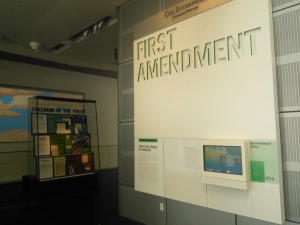After rising from the Nat’l Archives/Navy Memorial Metro station and approaching Pennsylvania Avenue, you will see massive examples of the neo-classical architecture that dominate the Washington scene: The National Archives, the Federal Trade Commission Building and the Capitol. Peeking over to the northwest is the ever-prominent Washington Monument. However, as you look down the street towards the Capitol, one building sticks out in particular: the Newseum.
The first thing you notice is the First Amendment embossed on a massive slab of rock, covering at least four stories of the south face of the building. Upon entering, you are greeted by an LED ticker wrapping around the second floor’s balcony, displaying news from around the globe.
As the outer wall and name state, exhibits in the Newseum focus around the news, the First Amendment and journalism.
One of the more prominent exhibits in the museum shows how “free” the press is around the globe and the risks of journalism. A large map takes up a major portion of the wall, denoting countries with “free”,”mostly free” and “not free” presses. According to the exhibit, a mere one in seven people live in a nation where the press is completely free.
Nearby, an old pickup truck is littered with bullet holes in its side due to its presence in the Balkans Conflict in the 1990s. A photograph is ballooned up behind the truck, showing a journalist in the middle of a gunfight in South Africa.
Across the hall, there is a massive wall with pictures of hundreds of people from all over the globe. This wall is a memorial to journalists, displaying the photographs of hundreds of slain reporters, cameramen, etc. Nearby, there is already a memorial dedicated to the two journalists slain in Moneta, Virginia on live camera on August 26.
With these exhibits, the Newseum shows that journalism is an important and dangerous profession. Without journalists, the Berlin Wall may not have come down, China’s actions at Tiananmen Square may have not been exposed on a large scale and vivid, horrifying images of the Vietnam Conflict may have never made it to the American living room, which could have caused a prolonging of the war.
The Newseum also exhibits the importance of the First Amendment and how it has been championed and contested throughout history, showing that no freedom is ever free. One example the museum puts forward is of a group of students who wore peace sign laden armbands to school during the Vietnam Conflict. They were suspended due to their resistance to the school’s dress code. They took the issue to court and after a long, arduous battle, the students won the battle in the historic Tinker vs. Des Moines Independent School District case.
On the First Amendment in schools, Mrs. Scioli, an AP Government and Politics teacher at Leesville, cited the Morse v. Frederick case, in which a student was suspended for holding up a paper sign while on a field trip to an Olympic Torch relay parade. Mrs. Scioli said that the Supreme Court “upheld the [school’s] decision…saying that [the student’s actions] reflected on the school.”
The information from museums casts a bright message to those who visit them, helping them better understand our nation’s past and allowing them to comprehend the importance of the rights we often take for granted. We too regularly forget that the very “unalienable rights” Thomas Jefferson wrote about in the Declaration of Independence didn’t come easily and still need to be protected, whether it be in the halls of academic institutions or in the halls of Congress.

Leave a Reply